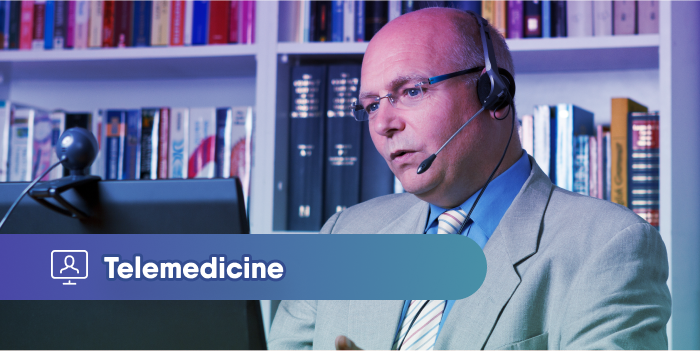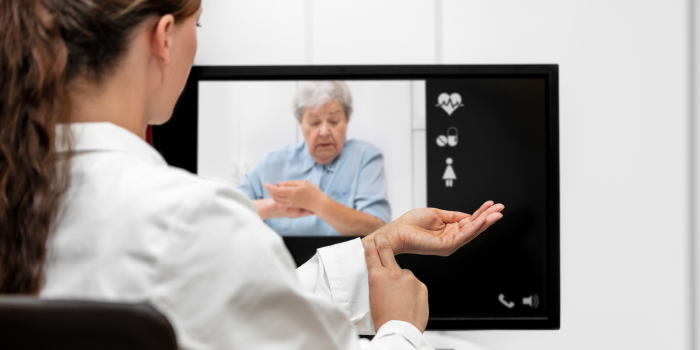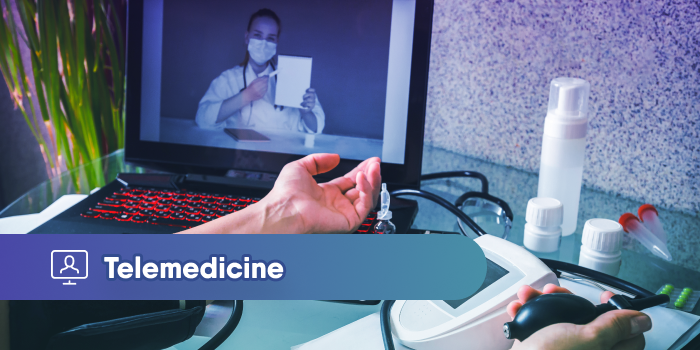Telehealth — Mental Health for the 21st Century
Telemedicine is a fast-growing segment of the healthcare industry. With many calling it the future of medicine, remote care has brought numerous...
Telemedicine is rapidly gaining acceptance in the U.S., especially as an effective way to provide healthcare services to patients safely during the COVID-19 emergency. More and more patients and healthcare providers are leveraging modern telecommunications technology to receive and deliver medical services remotely.
One thing that is holding back healthcare providers and proves to be an obstacle in the widespread adoption of telemedicine is the complexity around the reimbursement for remote healthcare services.
The main issue with CPT codes stems from the fact that the guidelines for billing telemedicine are still being formed. Apart from rapidly changing, the billing guidelines also vary between payers—private payers, Medicaid, Medicare.
This often results in confusion, with healthcare providers not knowing or being unsure about what to bill for telemedicine services and which codes to use. The fact of the matter is, a good number of states have telemedicine parity laws, mandating reimbursement for telemedicine, often at the same rates as if the services were delivered in-person.
Most major commercial payers in the U.S. cover telemedicine services. This includes:
Medicare also covers a range of telemedicine services and has even expanded the array of reimbursable remote healthcare services during the COVID-19 pandemic.
That said, if you’re planning on embracing telemedicine, you should always check to see if the patient’s insurance plan covers remote healthcare—and if so, what services are included.
Check our comprehensive telemedicine reimbursement by state article to get a quick idea of telemedicine reimbursement policies across the United States.
Even when telemedicine services are covered by the patient’s insurance plan, you still need to know how to properly bill for the medical services you delivered using telemedicine. This includes selecting the right CPT code and the right modifier when sending the medical bill.
In this article, we’ll explain what CPT codes are, go over the different types of CPT codes applicable to telemedicine encounters, and provide you with detailed lists that will help you correctly bill for remote healthcare services.
The Current Procedural Terminology codes—CPT for short—are a set of medical codes provided and maintained by the American Medical Association (AMA). The idea behind CPT codes is to create a uniform standard that medical professionals, patients, and payers use when referring to a wide range of medical services for financial and administrative purposes.
CPT codes describe testing, surgical procedures, diagnostic services, and all other medical procedures that a healthcare professional provides to a patient. In conjunction with the International Classification of Diseases (ICD) codes, CPT codes tell payers everything they need to know to reimburse you for telemedicine services—what symptoms the patient exhibited and what medical services you delivered to treat their condition.
The CPT code set is enormous, giving that it covers thousands of different medical procedures. In this article, we’ll highlight the ones that are applicable to telemedicine encounters, but first—let’s take a look at the different categories of CPT codes.
CPT codes are five characters long, and the five characters can either be numerals only or a combination of letters and numbers, depending on the category. The codes are divided into three categories:
CPT codes are the primary source of income for the American Medical Association. The AMA and the CPT Editorial Board update the CPT codebook yearly in October, so make sure you’re referring to the latest edition of the codebook when billing medical services.
The codes from the first category are the most commonly used by healthcare professionals. They are divided into six sub-sections, with each grouping pertaining to a particular field of healthcare.
The six subsections of Category I of the CPT codebook are:
Throughout the CPT codebook, the codes are listed in ascending numerical order. One exception to this are the Evaluation and Management codes, which are provided at the top of the codebook, given the fact that they’re most often used by physicians to report a large number of services they provide.
|
Category I CPT codes |
|
|
Medical field |
Numerical range |
|
Evaluation and Management |
99201–99499 |
|
Anesthesia |
00100–01999; 99100–99140 |
|
Surgery |
10021–69990 |
|
Radiology |
70010–79999 |
|
Pathology and Laboratory |
80047–89398 |
|
Medicine |
90281–99199; 99500–99607 |
Category II codes contain four digits and a letter F at the end. They are optional and can be used in addition to Category I codes to provide valuable information that can be used in performance management and future patient care.
Category II codes are also separated into different numerical subsets, corresponding to a specific element of patient care.
Some of the common subsets of Category II CPT codes include:
Category III is reserved for temporary codes, which describe new, experimental medical services or procedures, or new technology. One thing to note is that Category I has codes for “unlisted procedures,” but if a procedure is listed in Category III, providers have to use the Category III code.
As we’ve mentioned, the CPT Editorial Board reviews the codebook each year and may choose to include a code that was previously listed under the third category into Category I.
Regardless of whether a certain code remains under Category III or is transferred into Category I, all codes within Category III are archived in the CPT manual for five years and can be used as such.
Now that we’ve covered what CPT codes and provided a quick overview of the different categories, let’s take a closer look at the CPT codes commonly used in telemedicine and telehealth billing.
Before you reference the table below, we strongly recommend that you familiarize yourself with telemedicine and telehealth laws in your state. Different laws, rules, regulations, and policies may apply to remote healthcare services, depending on where your practice is located, which may reflect the reimbursement of telemedicine by different payers.
Check out our blog to read about telemedicine and telehealth laws in various states, and be sure to read our comprehensive telemedicine reimbursement by state guide.
With that out of the way, here’s a detailed table of billable CPT codes for telemedicine services:
|
Telemedicine CPT codes 2020 |
|||
| Remote healthcare services | CPT codes | Allowed by the CPT codebook | Allowed by CMS |
| Office or other outpatient visits | 99201–99215 |
✅ |
✅ |
| Office consultation | 99241-99245 |
✅ |
|
| Subsequent hospital care services | 99231–99233 |
✅ |
✅ |
| Pharmacologic management, including prescription and review of medication | 90863 |
✅ |
|
| Subsequent nursing facility care services | 99307–99310 |
✅ |
✅ |
| Prolonged service in the office or other outpatient setting requiring direct patient contact | 99354, 99355 |
✅ |
✅ |
| Prolonged service in the inpatient or observation setting, requiring unit/floor time beyond the usual service | 99356, 99357 |
✅ |
|
| Interactive complexity | 90785 |
✅ |
|
| Psychiatric diagnostic interview examination | 90791, 90792 |
✅ |
✅ |
| Psychoanalysis | 90845 |
✅ |
✅ |
| Neurobehavioral status examination | 96116 |
✅ |
✅ |
| Individual psychotherapy | 90832–90834, 90836–90838 |
✅ |
✅ |
| Psychotherapy for crisis | 90839, 90840 |
✅ |
|
| Inpatient consultation | 99251-99255 |
✅ |
|
| Transitional care management services | 99495, 99496 |
✅ |
✅ |
| Family psychotherapy—without the patient present | 90846 |
✅ |
✅ |
| Family psychotherapy (conjoint psychotherapy)—with the patient present | 90847 |
✅ |
✅ |
| End-Stage Renal Disease (ESRD) | 90951, 90952, 90954, 90955, 90957, 90958, 90960, 90961 |
✅ |
✅ |
| ESRD related services for home dialysis per full month, for patients, (age-specific) | 90963, 90964, 90965 |
✅ |
|
| ESRD related services for home dialysis per full month, for patients 20 years of age and older | 90966 |
✅ |
|
| ESRD related services for dialysis less than a full month of service, per day (age-specific) | 90967, 90968, 90969, 90970 |
✅ |
|
| Individual and group medical nutrition therapy | G0270 |
✅ |
✅ |
| 97802–97804 | |||
| Smoking cessation services | G0436, G0437 |
✅ |
|
| 99406, 99407 |
✅ |
||
| Alcohol and/or substance (other than tobacco) abuse structured assessment and intervention services | G0396, G0397 |
✅ |
|
| 99408-99409 |
✅ |
||
| Remote imaging for detection of retinal disease with analysis and report under physician supervision, unilateral or bilateral | 92227 |
✅ |
|
| Remote imaging for monitoring and management of active retinal disease | 92228 |
✅ |
|
| Administration of patient-focused health risk assessment instrument | 96160 |
✅ |
|
| Administration of caregiver-focused health risk assessment instrument | 96161 |
✅ |
|
| External mobile cardiovascular telemetry with electrocardiographic recording, concurrent computerized real-time data analysis and greater than 24 hours of accessible ECG data storage (retrievable with a query) with ECG triggered and patient selected events transmitted to a remote attended surveillance center for up to 30 days | 93228, 93229 |
✅ |
|
| External patient and, when performed, auto-activated electrocardiographic rhythm derived event recording with symptom-related memory loop with remote download capability up to 30 days, 24-hour attended monitoring; includes transmission, review, and interpretation by a physician or other qualified healthcare professional | 93268, 93270-93272 |
✅ |
|
| Medical genetics and genetic counseling services, each 30 minutes face-to-face with patient/family | 96040 |
✅ |
|
| Individual and group health and behavior assessment and intervention | 96150–96154 |
✅ |
|
| Education and training for patient self-management by a qualified, nonphysician health care professional using a standardized curriculum, face-to-face with the patient (could include caregiver/family) each 30 minutes | 98960, 98961, 98962 |
✅ |
|
| Telehealth Pharmacologic Management | G0459 |
✅ |
|
| Annual Wellness Visit, including a personalized prevention plan of service (PPPS) first visit | G0438 |
✅ |
|
| Annual Wellness Visit, including a personalized prevention plan of service (PPPS) subsequent visit | G0439 |
✅ |
|
| Annual alcohol misuse screening, 15 minutes | G0442 |
✅ |
|
| Brief face-to-face behavioral counseling for alcohol misuse, 15 minutes | G0443 |
✅ |
|
| Annual depression screening, 15 minutes | G0444 |
✅ |
|
| High-intensity behavioral counseling to prevent sexually transmitted infection; performed semi-annually, 30 minutes | G0445 |
✅ |
|
| Annual, face-to-face intensive behavioral therapy for cardiovascular disease, individual, 15 minutes | G0446 |
✅ |
|
| Face-to-face behavioral counseling for obesity, 15 minutes | G0447 |
✅ |
|
| Critical Care Telehealth consult, initial, 60 minutes | G0508 |
✅ |
|
| Critical Care Telehealth consult, subsequent, 50 minutes | G0509 |
✅ |
|
| Individual and group kidney disease education services | G0420, G0421 |
✅ |
|
| Individual and group diabetes self-management training services | G0108 and G0109 |
✅ |
|
| Telehealth consultations, emergency department or initial inpatient | G0425—G0427 |
✅ |
|
| Follow-up inpatient telehealth consultations furnished to beneficiaries in hospitals or SNFs | G0406—G0408 |
✅ |
|
| Comprehensive assessment of and care planning by the physician or other qualified health care professional for patients requiring chronic care management services (add-on code) | G0506 |
✅ |
|
| Prolonged preventive service(s) in the office or other outpatient setting requiring direct patient contact beyond the usual service | G0513, G0514 |
✅ |
|
| Office-based treatment for opioid use disorder | G2086—G2088 |
✅ |
|
We strongly recommend bookmarking this page, so you can easily reference this comprehensive list of billable telemedicine and telehealth services in the future.
In response to the COVID-19 public health emergency, the Centers for Medicare & Medicaid Services (CMS) has made a few additions to the list above, allowing for several other medical services to be delivered via telemedicine.
|
Telemedicine services added by CMS in the face of the COVID-19 PHE |
|
|
Telemedicine service |
CPT codes |
| Emergency Department Visits | 99281–99285 |
| Observation Initial Care | 99218–99220 |
| Subsequent Observation Care | 99224–99226 |
| Same Day Admission/Discharge | 99234–99236 |
| Observation Discharge | 99217 |
| Initial Hospital Care | 99221–99223 |
| Hospital Discharge | 99238–99239 |
| Initial/Subsequent Intensive Care | 99477–99480 |
| Hourly Critical Care | 99291–99292 |
| Initial Critical NICU/PICU | 99468–99473 |
| Subsequent Critical NICU/PICU | 99475–99476 |
| Care Planning | 99483 |
| Initial Nursing Facility | 99304–99306 |
| Nursing Facility Discharge | 99315–99316 |
| Home Visits |
99341–99345 99347–99350 |
|
Domiciliary, Rest Home, or Custodial Care Services |
99327–99328, 99334–99337 |
|
Psychological or Neuropsychological Testing |
96130–96133, 96136–96139 |
| Physical Therapy/Occupational Therapy Services | 97161–97168; 97110, 97112, 97116, 97535, 97750, 97755, 97760, 97761, 92521–92524, 92507 |
| Radiation Treatment | 77427 |
Keep in mind that these codes are added by Centers for Medicare & Medicaid Services (CMS) for the duration of the COVID-19 pandemic, and are not allowed by CPT. In other words, these services are reimbursable by Medicare and Medicaid, when provided to the programs’ members, but private payers aren’t required to reimburse you for these services.
Apart from using the correct CPT code when billing for telemedicine and telehealth services, you also need to use the correct modifiers, depending on the nature of the provided service.
There are currently three different modifiers used when billing telemedicine and telehealth services:
The GT/GQ modifier is used when billing to Medicare, alongside the CPT code, to indicate that the service was delivered through synchronous telecommunication (GT) or via asynchronous telecommunication (GQ).
In 2018, CMS replaced the GT modifier with POS02. That said, some payers still recognize, and often even prefer the GT modifier. In addition, the GT modifier is also used for institutional claims billed under Critical Access Hospital (CAH), given that these claims do not use a POS code.
Providers must still use the GQ modifier when applicable—primarily for store-and-forward technology and remote health education.
Providers need to use the modifier 95 when billing to private payers, to indicate that the service was rendered via synchronous telecommunications channels. One thing to note is that Medicaid and Medicare do not recognize modifier 95. Some private payers might not recognize it either.
The safest course of action would be to use the POS02 modifier, but we would still advise you to consult the private payer or Medicare/Medicaid and inquire about billable telemedicine and telehealth services and applicable CPT codes and modifiers, before providing remote healthcare services to a patient.
POS02 is the new modifier, introduced by CMS in 2018. CMS defines this modifier as “the location where health services and health-related services are provided or received, through a telecommunication system.”
In practice, this means that POS02 is commonly used when billing CMS claims for synchronous telemedicine visits (live, two-way audio-video encounters).
Looking at all the technical conundrums, it’s not difficult to understand why some healthcare providers shy away from telemedicine. It’s not just the CPT codes—you also need to worry about:
Let’s do a quick thought experiment. Imagine none of the above-mentioned obstacles existed, and you could set up your virtual clinic and start seeing patients online in less than 48 hours. That would be the dream scenario, wouldn’t it?
With Curogram, this is a reality! We’ve spent years creating an ideal telemedicine solution that would allow healthcare providers to embrace telemedicine quickly and painlessly—and we succeeded!
When you choose Curogram, you don’t have to worry about the technical details at all. We’ve taken care of everything from you—our platform is fully HIPAA compliant, integrates with virtually any EHR, mimics your in-person workflows, and has a built-in billing function, making it incredibly easy to deliver and bill for telemedicine and telehealth services.
If you want to learn more about Curogram and test out its advanced features in practice, sign up for a free demo today.

Telemedicine is a fast-growing segment of the healthcare industry. With many calling it the future of medicine, remote care has brought numerous...

The COVID-19 pandemic poses a serious threat to healthcare providers and patients. Telehealth services offer ways to mitigate these safety concerns....

Telemedicine, as a remote patient care model, is not a new practice in healthcare and existed for many years before the COVID-19 pandemic. It was...